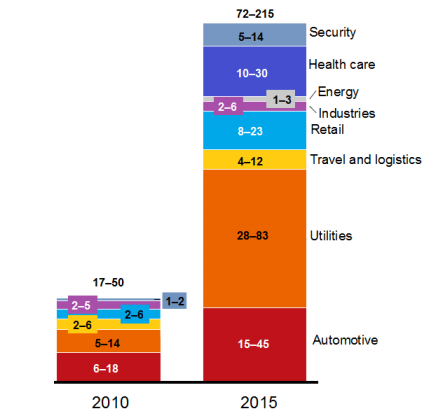2013: The year of the Internet of Things
Back in 1999, a technologist called Kevin Ashton pointed out that almost all the information available on the internet–a mere 50 petabytes at that time–had been captured or created by humans in the form of text, photos, videos etc.

Ashton suggested that this was likely to change in the not too distant future as computers became capable of generating and collecting data by themselves, without human oversight.
The technologies required for this are relatively simple–RFID tags for tracking objects, low-power sensors for gathering data on everything from temperature and air quality to footsteps and motion detection, and finally low power actuators that can switch anything on and off–things like lights, heating and air conditioning systems, video cameras and so on.
Ashton called this system “the Internet of Things” and began a number of companies and initiatives to kickstart it.
Since then progress has been seemingly slow. Consumers have been underwhelmed by the idea of remotely controlling a toaster over the internet and disbelieving of claims that their fridge could reliably order milk before it runs out.
But today, Arkady Zaslavsky and pals at Australia’s national scientific research organisation, CSIRO, reveal how the enabling technologies that Ashton imagined have rapidly matured and that the Internet of Things is finally poised to burst into the mainstream.
They say this is creating a new generation of challenges. The huge volumes of data that the Internet of Things generate will have to be routed, captured, analysed and acted upon in timely relevant ways. Working out how to do this will be no easy task.
These problems are already being tackled in innovative ways that show off the capability of the Internet of Things. Each year in Australia, for example, biologists plant a million or so plots of different types of grain to see which grow best in a wide variety of conditions. These plots are situated all over the country and create a logistical nightmare for the relatively small team who must monitor both the environmental conditions and the rate of growth of the plants.
Their solution is a wireless sensor network that monitors what’s going on and sends the data back to the High Resolution Plant Phenomics Centre in Canberra which runs the experiments.
These sensors are currently deployed at just 40 sites and generate some 2 million data points per week. But the widespread adoption of this kind of technology looks set to revolutionise this kind of testing. What’s more, various cloud-based services are emerging that are designed to help manage these kinds of sensors and the data they produce.
Other examples abound. Various cities have kitted out their transport networks with sensors that broadcast the position of buses, trams and trains and make this data available to the public.
Various innovative apps now give commuters real-time updates on the position and likely arrival time of their next ride. Other sensors monitor traffic conditions allowing real-time optimisation of traffic flow.
Another example of the emergent Internet of Things is the widespread adoption of sensor technology to monitor sporting performance. Nike+ and Fitbit sensors collect data about workouts, send it to a central server which users can then access to analyse their performance. The collection and transmission happens largely without any human intervention.
Then there are the emerging applications aimed at everyday life. Ninja Blocks is an Australian start up that is developing the technology that allows anybody to monitor and control their homes remotely over the internet. They plan to ship their second batch of devices in March.
The message from Zaslavsky and co is that the Internet of Things is coming of age and growing at an exponential rate. If it doesn’t already influence your life in a way you recognise, it soon will.
Ref: arxiv.org/abs/1301.0159: Sensing as a Service and Big Data
Keep Reading
Most Popular
Large language models can do jaw-dropping things. But nobody knows exactly why.
And that's a problem. Figuring it out is one of the biggest scientific puzzles of our time and a crucial step towards controlling more powerful future models.
The problem with plug-in hybrids? Their drivers.
Plug-in hybrids are often sold as a transition to EVs, but new data from Europe shows we’re still underestimating the emissions they produce.
Google DeepMind’s new generative model makes Super Mario–like games from scratch
Genie learns how to control games by watching hours and hours of video. It could help train next-gen robots too.
How scientists traced a mysterious covid case back to six toilets
When wastewater surveillance turns into a hunt for a single infected individual, the ethics get tricky.
Stay connected
Get the latest updates from
MIT Technology Review
Discover special offers, top stories, upcoming events, and more.